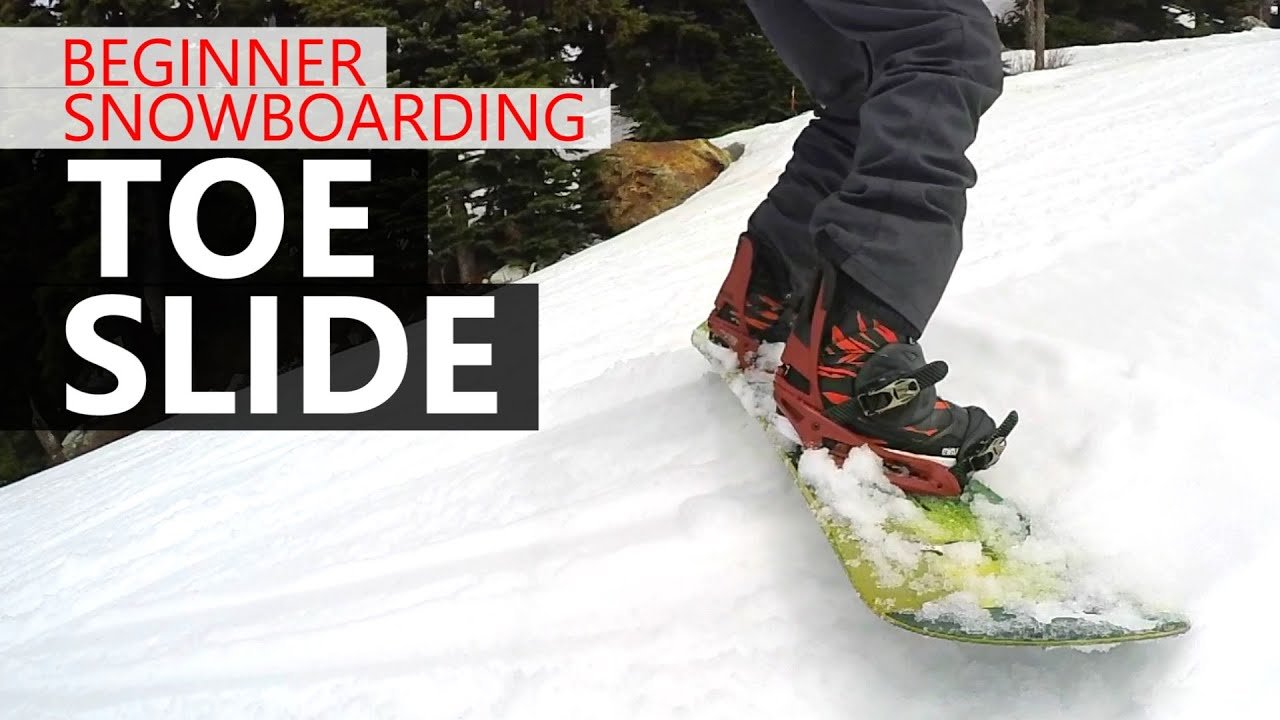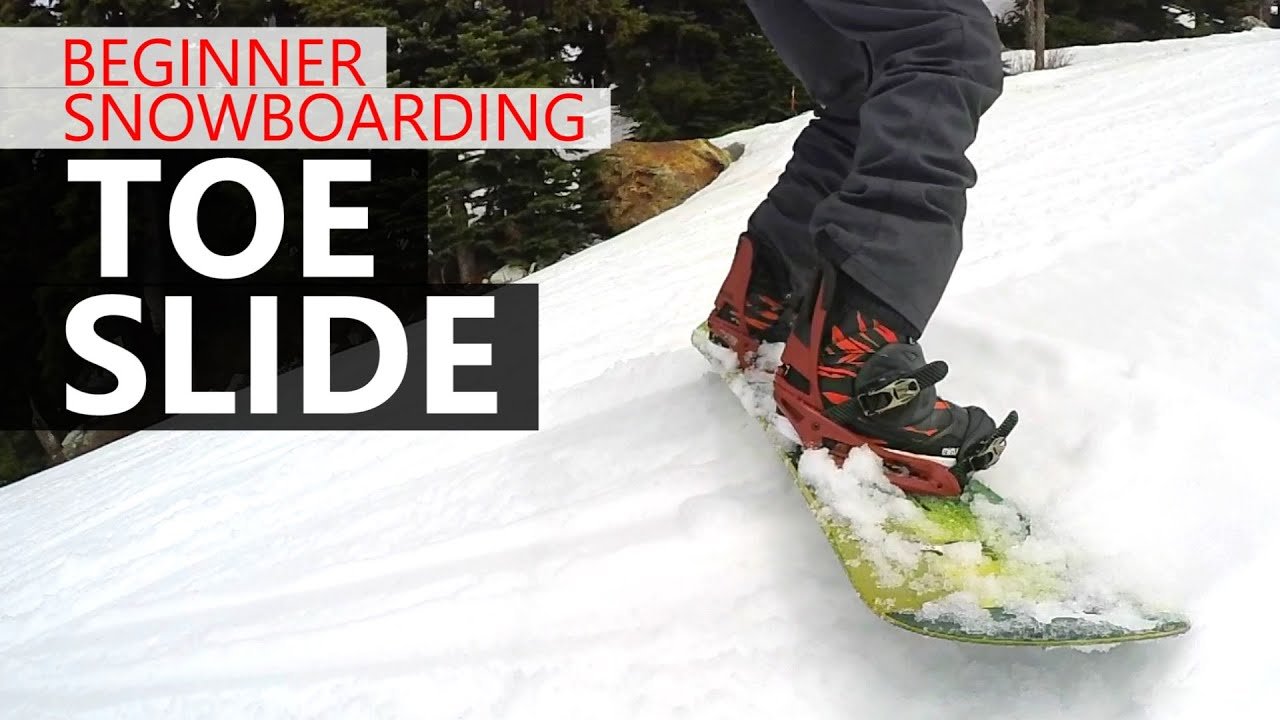
How to Toe Slide – Beginner Snowboarding Tutorial
In this beginner snowboarding tutorial, the focus is on learning how to toe slide, which is considered one of the most crucial skills to acquire on your first day. Toe sliding teaches you how to balance on your toe edge, control your speed, stop, and even change direction. The video, brought to you by SnowboardProCamp, emphasizes the importance of finding a gentle slope to practice on. The tutorial also encourages viewers to ask any questions they may have about toe sliding in the comment section. For more beginner snowboarding tips, the beginner snowboarding playlist is recommended.
Kevin from Snowboardprocamp begins the video by providing tips for toe sliding. He highlights the significance of this skill for beginner snowboarders, as it teaches them how to balance on their toes, control their speed, and make smooth movements across the mountain. Kevin stresses the importance of finding a suitable practice area with a gentle slope to start toe sliding. He provides detailed instructions on body positioning, such as bending the knees, keeping the hands over the board for balance, and looking towards the top of the slope. Kevin also addresses common problems related to toe sliding and offers solutions, such as equal weight distribution on both feet to prevent the board from going straight down the hill. Throughout the video, he encourages viewers to take their time and learn at their own pace, while also suggesting the assistance of a friend if needed.

Importance of Toe Sliding
When it comes to snowboarding, learning to toe slide is essential for beginners. This fundamental skill teaches balance on the toe edge, speed control and stopping, as well as changing direction. By mastering toe sliding, snowboarders gain confidence and control on the slopes, setting a solid foundation for future progression.
Teaches balance on toe edge
Toe sliding is a crucial technique that helps beginners develop balance and stability on their toe edge. By bending their knees towards the snow and getting on the toe edge, snowboarders learn to distribute their weight evenly and maintain control. This balance is essential for executing turns and maneuvers later on.
Teaches speed control and stopping
Learning how to control speed and stop is vital for every snowboarder, regardless of their skill level. Toe sliding allows beginners to slow down by digging their toes in the snow. By understanding how to adjust their weight distribution and utilize their toe edge effectively, snowboarders can regulate their speed and come to a safe stop.
Teaches changing direction
In addition to balance and speed control, toe sliding also teaches beginners how to change direction smoothly and efficiently. By learning to shift their weight and adjust their body position, snowboarders can initiate turns and move back and forth across the mountain effortlessly. Mastering this skill is crucial for navigating various terrains and slopes.
Finding the Right Slope
Choosing the right slope to practice toe sliding is essential for beginners. It is recommended to start on a mellow slope that provides a gentle incline. This allows beginners to focus on the technique without feeling overwhelmed or intimidated by steep terrain. By selecting a safe area for practice, beginners can build their skills and gain confidence before venturing onto more challenging slopes.
Importance of practicing in a safe area
Practicing in a safe area is crucial for beginners learning to toe slide. A designated beginner area or a wide-open space with minimal obstacles provides a conducive environment for practicing and honing the technique. This ensures that beginners can navigate their movements without the risk of collisions or accidents. Safety should always be a top priority when learning any new snowboarding skill.
Basic Technique of Toe Sliding
To master the technique of toe sliding, beginners should focus on the following key aspects:
Bending knees towards the snow
The first step in toe sliding is to bend your knees towards the snow. This lower body position helps establish a stable base and allows for better weight distribution. By bending the knees, beginners can engage their leg muscles and maintain balance throughout the movement.
Getting on the toe edge
After bending the knees, beginners should then focus on getting on their toe edge. This involves shifting the weight to the front foot and leaning slightly forward. By utilizing the toe edge, snowboarders can gain control and stability, making it easier to initiate movements and maneuvers.
Keeping the heel edge up
In toe sliding, it is crucial to keep the heel edge of the snowboard lifted and off the snow. This position allows for a smooth glide along the slope, preventing any unwanted dragging or catching of the board. By maintaining a lifted heel edge, beginners can minimize resistance and maximize control.
Maintaining balance with hands
As beginners master the technique of toe sliding, it is essential to maintain balance with the help of their hands. Keeping the hands positioned over the top of the board provides stability and supports the body’s weight distribution. Beginners should avoid excessively using their hands for balance, but rather use them as a supplementary tool to maintain control.
Looking towards the top
Another important aspect of toe sliding is to keep the head and gaze directed towards the top of the slope. This helps with maintaining balance and body alignment. By focusing on the top, beginners can keep their movements fluid and have a better sense of their surroundings.
Controlling Speed and Stopping
Controlling speed and knowing how to stop are crucial skills for any snowboarder. In toe sliding, these skills can be developed through specific techniques:
Digging toes in to slow down
To slow down while toe sliding, beginners should actively dig their toes into the snow. By applying pressure on the toes, the snowboard creates more friction against the slope, resulting in a decrease in speed. Beginners should gradually experiment with different amounts of pressure to find the right balance between control and deceleration.
Keeping heel edge close to the snow to increase speed
On the opposite end of the spectrum, beginners can increase their speed during toe sliding by bringing their heel edge closer to the snow. This positioning reduces friction and allows the snowboard to glide more freely. By finding the right balance, beginners can control their speed effectively and comfortably.
Finding the right balance for smooth backward sliding
To execute smooth backward sliding while toe sliding, beginners need to find the right balance between their weight distribution and the angle of their board. By experimenting with weight shifts and board positioning, beginners can achieve a seamless and controlled backward slide.
Stopping by digging toes in
The ability to stop effectively is essential for any snowboarder. In toe sliding, beginners can bring themselves to a halt by digging their toes into the snow and applying pressure. This technique allows for a controlled and gradual stop, ensuring safety and stability on the slope.
Sliding Back and Forth
Once beginners have mastered the basic technique of toe sliding, they can progress to sliding back and forth across the slope. This movement is essential for navigating different terrains and practicing directional changes. Here’s how beginners can achieve smooth and controlled sliding back and forth:
Moving the board to the right
To initiate movement towards the right, beginners should start sliding while looking their head down to the right. By shifting their body weight and aligning their board accordingly, they can control the direction and glide smoothly across the slope.
Moving the board to the left
Similarly, moving the board to the left requires beginners to initiate sliding and then look their head to the left. By shifting their weight and adjusting their body position, they can maintain control and confidently slide in the desired direction.
Maintaining control and stopping
Throughout the sliding back and forth motion, beginners should focus on maintaining control and stability. By adjusting their weight distribution and keeping their gaze aligned with their intended direction, they can ensure smooth transitions and execute stops effectively.
Common Problems with Toe Sliding
While learning to toe slide, beginners may encounter common problems that can affect their technique. Being aware of these challenges and knowing how to overcome them is essential for progress:
Making the board go straight downhill
One common problem in toe sliding is unintentionally making the board go straight downhill instead of sliding back and forth. When this happens, beginners can correct their path by facing their chest to the top of the slope and putting equal weight on both feet. This adjustment helps regain control and prevent the board from continuing downhill.
Correcting by facing chest to the top and equal weight on both feet
Facing the chest to the top of the slope and distributing weight equally on both feet is an effective correction technique in toe sliding. This adjustment helps maintain balance, control, and proper sliding direction.
Under-practicing toe sliding and its impact on turning
Another common issue is under-practicing toe sliding, primarily due to the more comfortable nature of heel sliding. While it may be tempting to rely solely on heel sliding, neglecting toe sliding can hinder future progress, particularly when it comes to turning. It is essential to practice toe sliding just as much as heel sliding to develop well-rounded skills and maintain control on both edges.
Importance of Practicing Toe Sliding
Mastering toe sliding is essential for balanced skill development in snowboarding. It is important to balance the focus between practicing heel sliding and toe sliding. By allocating time and effort to toe sliding, beginners can prepare themselves for turning and gain better speed control on both edges.
Balancing the focus on heel sliding and toe sliding
To become a well-rounded snowboarder, it is crucial to balance the focus between heel sliding and toe sliding. By evenly dedicating time and effort to both techniques, beginners can develop versatile skills that enable them to face different slopes and situations confidently.
Preparation for turning and speed control on both edges
Toe sliding serves as a foundation for turning and speed control on both the heel and toe edges. By mastering toe sliding, beginners gain the necessary skills and confidence to execute turns effectively, regardless of the direction or terrain. Practicing toe sliding prepares snowboarders for more advanced maneuvers and enhances their overall control on the slopes.
Conclusion
In conclusion, toe sliding is an essential skill for beginners in snowboarding. It teaches balance on the toe edge, speed control, stopping, and changing direction. By finding the right slope and practicing in a safe area, beginners can develop and refine their toe sliding technique. By applying the basic technique, controlling speed and stopping effectively, and mastering sliding back and forth, beginners can gain confidence and control on the slopes.
While toe sliding may present common challenges, such as going straight downhill or under-practicing, these issues can be overcome with proper technique and practice. By allocating time and effort to toe sliding, beginners can balance their skill development and prepare themselves for turning and speed control on both edges.
So take your time, practice at your own pace, and don’t hesitate to ask for help or guidance from more experienced snowboarders. With dedication and practice, toe sliding can become second nature, paving the way for a fun and rewarding snowboarding journey.
